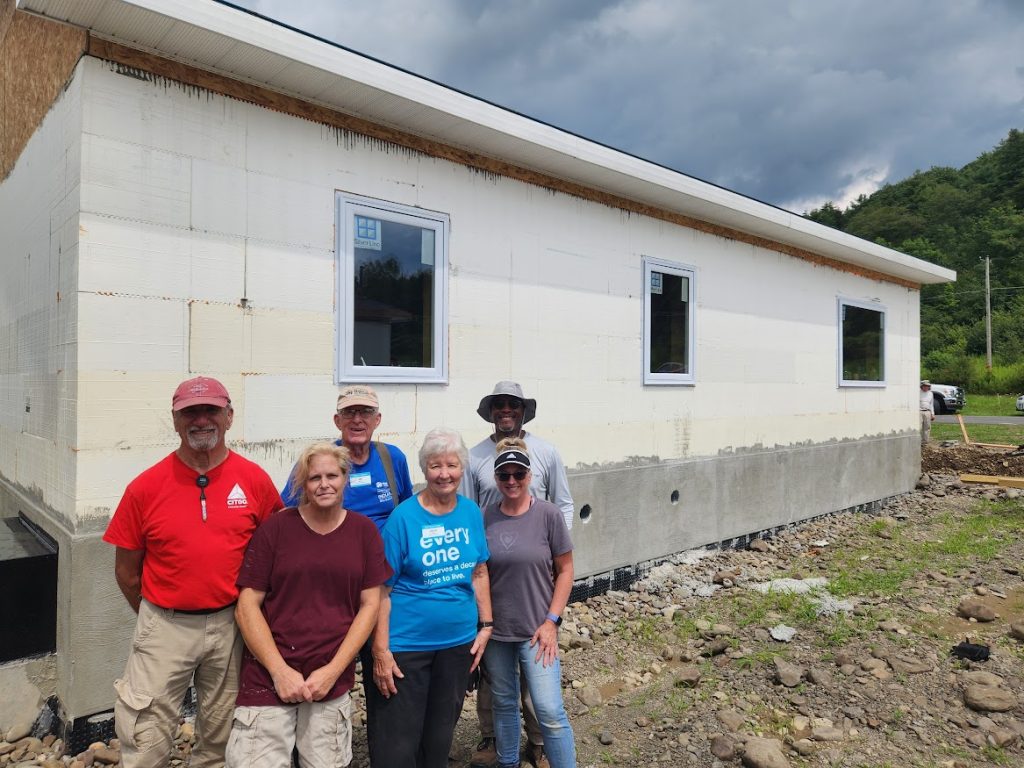
Habitat for Humanity ‘Care-A-Vanner’ Vols Visit Oneonta Site
By WRILEY NELSON
ONEONTA
Out-of-state visitors were among the volunteers at Habitat for Humanity of Otsego County’s work site at McFarland Road in Oneonta on Saturday, August 5. HFHOC took advantage of the national organization’s “Care-A-Vanner” program, in which volunteers from around the country drive their RVs to job sites to assist with construction, usually for two-week stints. The program is popular with retired or hobbyist RV travelers, who can add a meaningful and rewarding experience to their travels while helping out families across the country. Many Care-A-Vanners structure their vacation itineraries around different job sites and become highly skilled in construction. Their ability, energy and enthusiasm provide a major leg-up for small Habitat volunteer crews.
HFHOC has built five of a planned nine homes at the McFarland Road site, a former gravel quarry near the Otego Creek that was donated by a local board member. The local chapter has typically built one new home each year. With Care-A-Vanner help, and record numbers of local volunteers, they aim to finish two houses this year. The bi-weekly site update, posted on the HFHOC Facebook page on Sunday, August 6, reported significant progress on plumbing, wiring, roof sheathing, and fixtures such as doors, cellar hatchways, and windows.
Jay and Joyce Rush, long-serving volunteers from Pennsylvania, led the Care-A-Vanner team during its two-week stop in Oneonta.
“This is our sixth volunteer session,” Jay said. “We get treated really, really well. We do it because there’s a real need for the housing. We also get to meet great people on the Care-A-Vanner team and from the local affiliate, and the homeowners. That’s what I look forward to most, is getting to meet them.”
“One of our bylines is ‘travel with a purpose,’ Joyce added. “We get to travel all around the country, as far as we want to go, but then we’re able to do something useful while we’re doing that.”
Habitat for Humanity partner families help construct their own future houses and often help out with other construction sites; the organization calls this “sweat equity” and considers it a key factor in successful outcomes. They also receive assistance with loan applications and paperwork, and extensive training in the practical skills of owning and maintaining a home. Each day on a Habitat job site begins with a brief devotional emphasizing empowerment and self-help. Volunteers stand in a circle and recite, “It’s not a handout, it’s a hand up,” acting out the two ideas by raising their joined hands.
“They have full basements under all these houses,” Joyce Rush said. “Washers and dryers can go under there, but if the families want more room, they can always finish up the space. They can make the homes truly their own.”
James and Kelly, newly retired full-time RV travelers from Austin, Texas, said that Oneonta was their first construction site. They chose the location at random from an “almost unbelievable” number of Habitat chapters around the country calling for extra volunteers.
“Not only is it an opportunity to give, but I’m learning a lot of practical skills,” James said. Both repeatedly expressed their gratitude for the opportunity to travel, do life-changing volunteer work and meet other like-minded people on the road.
“Between our team and the local volunteers, we had 21 people here on Thursday,” Kelly said. “I’m told that’s a record for this chapter. There are about 15 here today, including representatives from each of the current partner families.”
The homes at McFarland Road are built using insulating concrete forms, which result in cast-in-place concrete walls sandwiched between layers of strong insulating materials. ICFs make for quick, easy construction and strong, disaster-resistant, and energy-efficient buildings. The concrete and insulation provide significant protection against sound, heat, and cold.
“The ICF forms go up like Lego blocks and then you fill the cavity with cement,” Jay explained. “Not only are you making a very solid house, but it’s insulated and airtight. They did a blower test on one of the completed homes; they wanted it to be under three air changes per hour, and they had it down to 0.6. It’ll be very energy-efficient.”
The partner families will be well served in Oneonta winters and summers alike.
“Note the large picture windows on the south side of the homes here,” added HFHOC board member Bruce Downie. “These houses are so well insulated that the sun coming through those windows will go a long way toward heating the interior.”
During the two-week Care-A-Vanner visit, HFHOC made long strides toward completing site houses six and seven. The volunteers, local and national, also put the finishing touches on house five. Oneonta-area Habitat members hope to finish the two 2023 houses before autumn.
“We really appreciate the extra help, and we try to make it a good experience for them,” Downie concluded. “It’s a give and take.”

